Affiliate Disclaimer
Some links in this article are affiliate links. We may earn a small commission if you make a purchase through these links, at no extra cost to you. We only recommend products we find useful to our readersTantric Yoga originated in India, Tibet thousands of years ago. This yoga is done for pleasure. To understand how to find pleasure in everything and not just sex, although, there are tantric sex yoga poses that couples can practice for better sex. Tantric yoga is about learning about your body and its needs. A good time to practice this would be early morning when everybody is asleep, near dawn.
Music is not necessary for tantric yoga. Because when we hear music we tend to sway on the beats of the song. We need to hear more to our body during tantric yoga. We have learn to do things in a certain way and not doing the same way as others makes us feel like we are doing something wrong. But experts say, finding your own way out during tantric yoga meditation is going to benefit your body mind and spiritual being.

Once you have warmed up to your own body after that the poses you do are for your own good. Most tantric yoga practices in studios also do not have music. Just a background voice. People go to the studio to meet a community of practitioners not to choreograph any moves in synchronicity. The idea is to bring your body and mind in sync with each other while you are at it.
What exactly is the Tantric Yoga? Is it Sex thing?
 Usually people have seen in films that tantric yoga is a couples’ yoga. And it is about improving you sexual drive and moves. But it is not only that. Tantric yoga has a lot more to offer. It is an ancient practice where asana, mudra, mantra come together. The bandha (energy lock) and chakra (energy center) work is for building strength, clarity, and siddhi (bliss) in everyday life.
Usually people have seen in films that tantric yoga is a couples’ yoga. And it is about improving you sexual drive and moves. But it is not only that. Tantric yoga has a lot more to offer. It is an ancient practice where asana, mudra, mantra come together. The bandha (energy lock) and chakra (energy center) work is for building strength, clarity, and siddhi (bliss) in everyday life.
In our everyday lives we are so pulled down by bodies, health and food. We need to see through these things and recognize our distinct self. Becoming happy in everyday life is a great achievement, and needs practice where different energies and their connections to the universe, the purpose of life and the connection to others can be explored. In the sense, tantric yoga practice is done in a different dimension.
There are four pillars of Tantra Yoga based on experience of different experts:
Mantra and Sankalpa
 One should have a sankalp: a goal, or vision with the daily tantra. You can also put on mantra on the music channels you listen to which will help your mind and body relax. You should practice your sankalp poses and meditate along.
One should have a sankalp: a goal, or vision with the daily tantra. You can also put on mantra on the music channels you listen to which will help your mind and body relax. You should practice your sankalp poses and meditate along.
Hatha Yoga
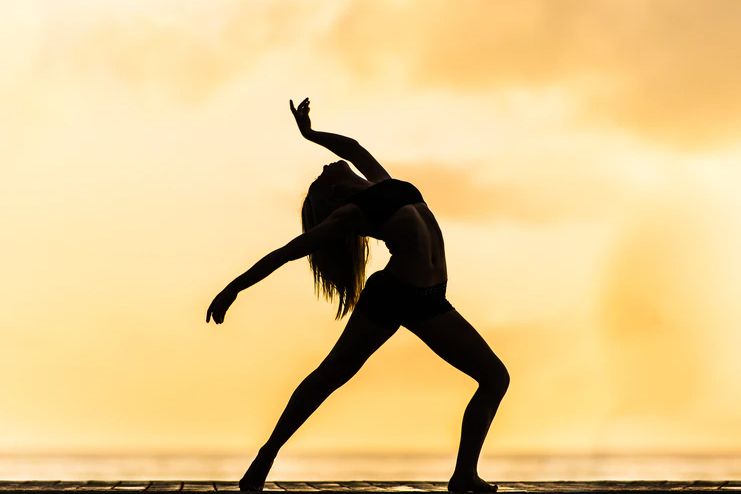 To get better at the stretches we need to build the strength in our hands. You can do handstand, as soon as you understand how to balance your body.
To get better at the stretches we need to build the strength in our hands. You can do handstand, as soon as you understand how to balance your body.
Kundalini Yoga
 This yoga helps remove negativity and works on your heart chakra. It is composed of breathing exercises and poses that you can do repetitively. Kundalini is an energy, which can move about and clear your chakras. It is said to be located in the base of your spin.
This yoga helps remove negativity and works on your heart chakra. It is composed of breathing exercises and poses that you can do repetitively. Kundalini is an energy, which can move about and clear your chakras. It is said to be located in the base of your spin.
Rajas Yoga
The yoga practice of self-discipline and control is called Raja Yoga. It is also called Ashtanga Yoga as it consists of eight parts. They are:
1. Yama (Self-control): If you don’t have self-control you will fall into the vicious circle of life which you want to get away from through this yoga.
2. Niyama (Discipline): Without this step you can do the yoga. Yoga is a learning practice where there will be many days where you may feel the need for discontinuity. But being consistent is the key.
3. Asana (Physical exercises): These are the sankalp that you have decided for your daily tantric yoga.
4. Pranayama (Breath exercises): To practice breathing. There are seven pranayam and each has its own benefits. Sit is savansana before your pranayam. You can do pranayam 60 times in a day- spread across the day. It will make you think well when you are in stress.
5. Pratyahara (Withdrawal of the senses from external objects): It is our own meditation in which we withdraw from the outer world and ring our bodies in tune with the inner world, where we are intelligent and calm.
6. Dharana (Concentration): Put yourself in a comfortable asana and prepare to concentrate on an object. This object can be a memory, a solid object like a candle and a picture or an idol. You must concentrate on the very object to seek as much information you can about it. But any distractions would mean an incomplete dharana.
7. Dhyana (Meditation): In dhyana, we are practically meditating. We try to hold on to an image in our minds. It is about absorbing everything around you than resisting it. Through this we try to listen to our hearbeat and breathing and ascertain detachment from the world.
8. Samadhi (Complete Realisation): Practicing Samadhi is very important in our everyday lives. The aim should be to take out time every day to speak to our unconscious. And clear it. Speaking about things we are grateful for and the memories which we remember as achievements. Samadhi brings our physical, spiritual, mental, and emotional beings together. We have to accept ourselves as we are. Feed ourselves with good thoughts and strategies for improvement.
How can we do this with Yoga and meditative practices?
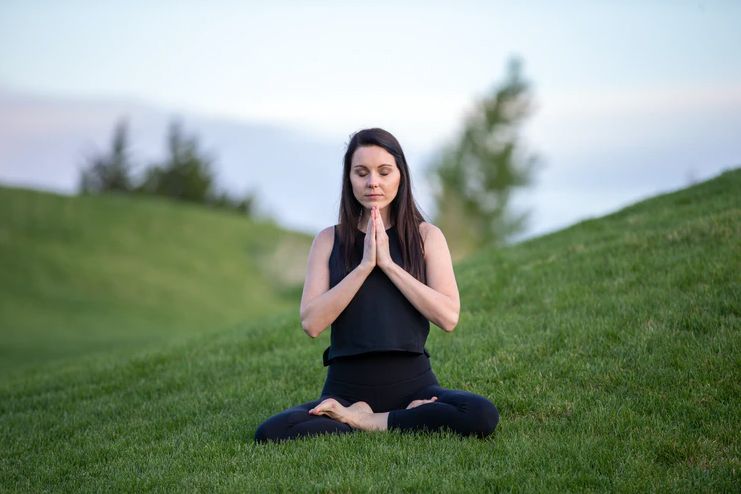 To begin with Tantric Yoga, prepare for a yearly routine, than a weekly or monthly goal setter. This is going to be a journey with yourself, your image and conscience. Practice tantric yoga every day since you have started reading about this. Learn from individual and community experiences. Write a gratitude journal and don’t be ashamed of knowing yourself.
To begin with Tantric Yoga, prepare for a yearly routine, than a weekly or monthly goal setter. This is going to be a journey with yourself, your image and conscience. Practice tantric yoga every day since you have started reading about this. Learn from individual and community experiences. Write a gratitude journal and don’t be ashamed of knowing yourself.
The steps to start the practice are as follows:
1. In your own home prepare a safe space which can be a studio or a place where you can find silence at one point in a day. You will need this place everyday for nearly a year or two.
2. Always begin with “eye gazing.” If you are alone, look around the whole room with only your eyes. Capture the whole sensation. If you are with somebody, sit up straight facing your partner and look into each other’s eyes.
3. Soon in a week or so, you will be able to create a circuit, which is a circular motion in you will practice the yoga, asana, mudra, mantra repetitively and regularly.
4. Move your body to complete and full stretches as you feel your body. Don’t do asanas in which you are not certain of their benefits. Slowly, add more physical exercises to your asanas, as you build your strength and stamina.
5. While you have conquered your breathing you should go as far as you are comfortable with your physical asanas. Conquer all poses with great balance and ease and then go onto the next pose. Do not try to copy others’ poses. Tantric yoga is about learning through your body.
6. As you are growing with each day, start experimenting with edging. Like balancing your body on one hand and one foot, these are different asanas in the book of yoga. But to you it must come as a gradual progression knowing what your body needs. When you are feeling tired you should be sure to stay a little longer in the asana and hold it- this is called edging.
How many Yoga postures do we have for Tantric Yoga, And What are they?
Tantric Yoga is goal oriented. It depends on what you need as an outcome from yoga. Is it good health, becoming stress-free, developing concentration, flexibility or confidence. There are a variety of outcomes you may want from your daily practice. People with high blood pressure, hiatus hernia, menstruation, pregnant women should not try these poses.
You may not achieve the best pose and form in the first attempts. But do not quit. Focus on your breathing whenever you are getting distracted. The idea is t bring calmness to your body and mind. For regular trainers the following tantric yoga poses may not be extremely strenuous. But these are the best tantric yoga poses to begin with.
You may practice your Shavasana and breathing before your physical poses. This will help build your way through the whole eight steps of tantra yoga explained in point two. Keeping your yes closes and focusing on your breathing and body is a good warm-up to begin with. You will sit straight with a tall spine and breathe in and out, with your abdomen and chest going up and down, as you inhale and exhale through your nostrils.
The following are the top 10 tantric yoga poses to practice for beginners:
1. Tadasana
 It can also be called mountain pose, standing arm raises. This pose helps build balance through increasing flexibility in your ankles, foot and joints. It will also make your spine more agile.
It can also be called mountain pose, standing arm raises. This pose helps build balance through increasing flexibility in your ankles, foot and joints. It will also make your spine more agile.
Step-by-step guide
-Stand on the yoga mat with distance between your legs.
-Hands alongside your body
-Deep inhale and exhale
-Inhale raise your arms above and interlock your fingers
-Stand on your toes
-Balance yourself for 10 seconds
2. Utkatasana
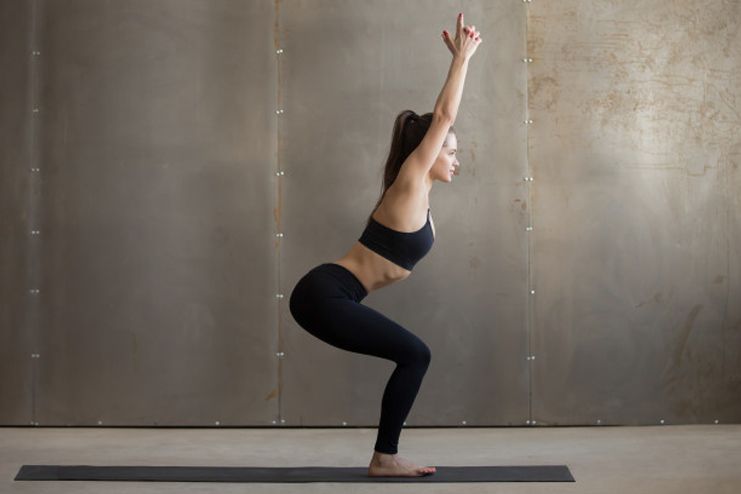 In this pose you stretch your shoulders, open your chest and bend your knees. This pose tones you shoulders, butts and back. It is a dynamic pose works on your thighs, Achilles tendons and shins. Its good for your digestive system and heart.
In this pose you stretch your shoulders, open your chest and bend your knees. This pose tones you shoulders, butts and back. It is a dynamic pose works on your thighs, Achilles tendons and shins. Its good for your digestive system and heart.
Step-by-step guide
-Stand on your yoga mat with legs apart at a certain distance
-Inhale deep in from your nostrils and exhale out
-Loosen your body
-Bend your knees and raise your arms 45 degrees to the mat
-Stick to this position for 10-15 seconds
3. Bitilasana to Adho Mukha Svanasana
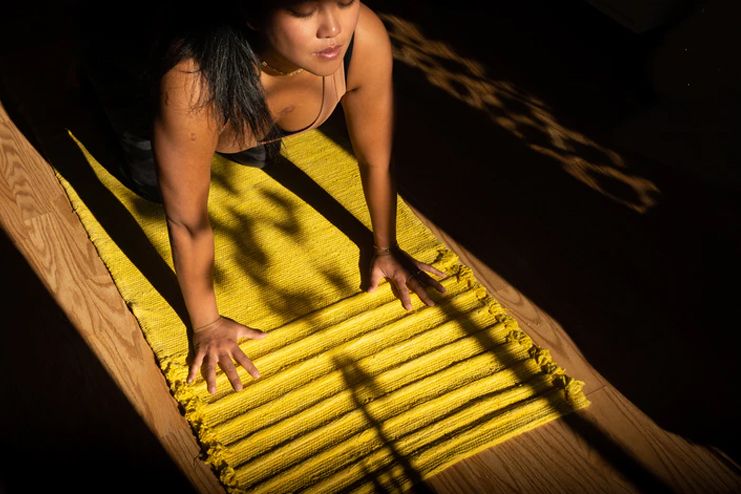 Can also be called cow pose to downward dog pose. In this your will stretching your shoulders in a more controlled way. This is good for your bones, brain, legs, arms and posture. This is a somewhat difficult pose. But if you follow hrough carefully, it will be a great way to start your day.
Can also be called cow pose to downward dog pose. In this your will stretching your shoulders in a more controlled way. This is good for your bones, brain, legs, arms and posture. This is a somewhat difficult pose. But if you follow hrough carefully, it will be a great way to start your day.
Step-by-step guide
-Stand with legs apart and heels flat
-Keeps knees right under your hips
-Bring wrists to shoulder height
-Head neutral, gazing at the floor
-Open your chest and at the same time raise your hips towards the roof and stomach towards the ground
-Turn your gaze and look in forward direction
-Hold the pose for 10-15 seconds
-exhale and forward bend
-Cat pose: Keep your hands on the floor and stand on your knees.
– Stretch as far you can keeping yourself in triangle pose
-keep your heels flat
-Exhale and go to the starting point
4. Virabhadrasana I
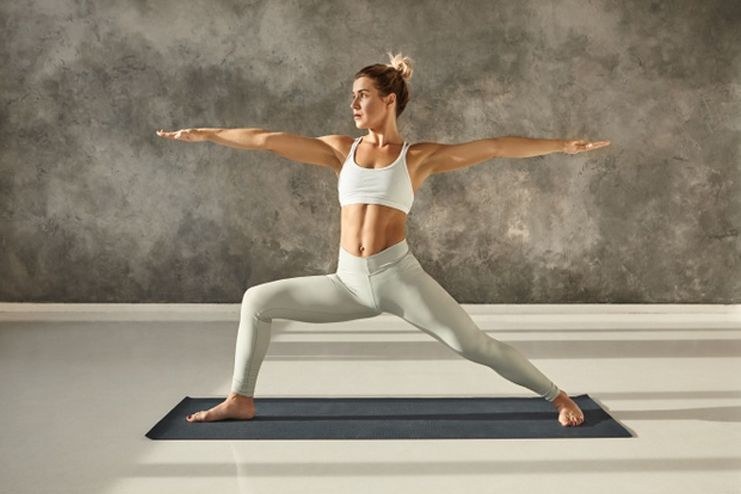 It can also be called warrior pose. There are many variations of this pose and this is one of them. This energises your entire body. Improves focus, blood circulation, respiration. Opens your hips, chest, shoulders and spine. During this pose you heels are on the floor throughout. You can do up to three repetitions of this.
It can also be called warrior pose. There are many variations of this pose and this is one of them. This energises your entire body. Improves focus, blood circulation, respiration. Opens your hips, chest, shoulders and spine. During this pose you heels are on the floor throughout. You can do up to three repetitions of this.
Step-by-step guide
-Stand with right foot in front and left foot behind your back and hips flat on the floor.
-Bend your front right foot to 90 degrees and left foot to 15 degrees making sure that the left foot and right foot are aligned so that right foot is in the centre of the left foot.
-Exhale. Make sure that your knee is not going ahead of your ankle and bend your knee as far as possible.
-Keep your hands stretched parallel to the legs
-Hold this position for 10-15 seconds
-Inhale and turn your gaze in the other direction.
-Repeat the same with opposite legs
-Inhale and stand straight
-Begin from the starting point
5. Prasarita Padottanasana
 It can also be called wide-legged standing forward bend. This pose reduces your anxiety and stress. Works on strengthening your spine making it flexible. Strengthens your thighs, hamstrings, hips and calves. Activated abdominal muscles and relieves tension from the body.
It can also be called wide-legged standing forward bend. This pose reduces your anxiety and stress. Works on strengthening your spine making it flexible. Strengthens your thighs, hamstrings, hips and calves. Activated abdominal muscles and relieves tension from the body.
Step-by-step guide
-Stand straight with legs apart on the mat
-Knit the rib cage together keeping your spine and abs as one
-Raise your arms upwards and exhale
-Inhale and bend your waist and bring your hands to the floor keeping your heels flat
-Touch the floor with your hands flat and top of the head touching the floor
-Hold this position for 10-15 seconds looking behind your legs
-Stand straight and repeat
6. Agnisar kriya
 This pose stokes digestion and eliminates waste and toxins from your body. It can be practiced with a full stomach in case of constipation too. Also It is a kind of pranayam. Even It strengthens your core and centres your scattered energies. It is okay if you cannot feel your diaphragm going completely inside
This pose stokes digestion and eliminates waste and toxins from your body. It can be practiced with a full stomach in case of constipation too. Also It is a kind of pranayam. Even It strengthens your core and centres your scattered energies. It is okay if you cannot feel your diaphragm going completely inside
Step-by step guide
-Feel your diaphragm as you are standing on the mat
-Bend your back forward and gaze towards to floor
-Keep your hands on your knees
-Breathe in, inhale and tuck your diaphragm inside
– Hold on for as many breaths as you can
-Exhale and repeat
7. Ardha navasana
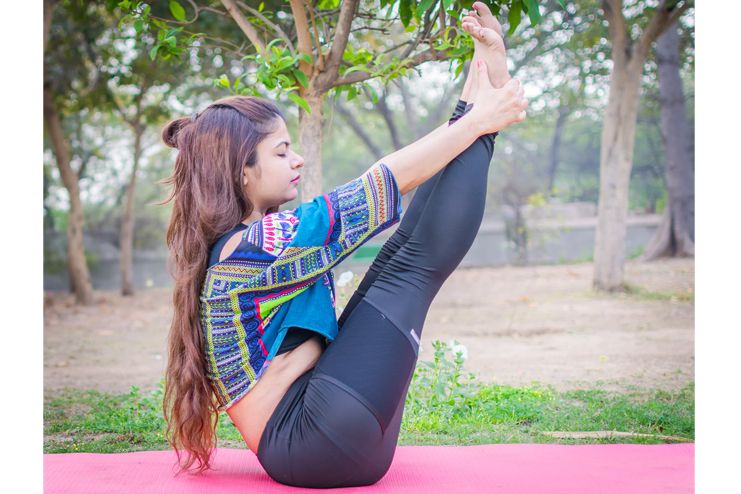 This can also be called the boat pose. This is for strong abs and core. It activates your digestive organs and opens up your abdominal muscles. It is okay to feel a slight pain in your abdomen while performing this pose.
This can also be called the boat pose. This is for strong abs and core. It activates your digestive organs and opens up your abdominal muscles. It is okay to feel a slight pain in your abdomen while performing this pose.
Step-by-step guide
-Sit straight with a tall spine on a yoga mat or on the floor.
-Bring your legs in front of you keeping the back neutral
-Slowly bend your legs and knees by brings your heels close to your glutes
-Keep your hands alongside your body on the floor
-Stretch your legs outward and bring them back to the bent position
-You can elevate your hand up parallel to the floor
-Keep stretching your legs inwards and outward for 20-30 seconds
-Breathe in stretch out and breathe out relax
-Repeat from the starting point
8. Tadaka Mudra
 This pose is good for your spinal alignment. It strengthens your core and builds confidence. This will improve your breathing working through your respiratory organs too.
This pose is good for your spinal alignment. It strengthens your core and builds confidence. This will improve your breathing working through your respiratory organs too.
Step-by-step guide
-Lie down flat on your mat or on the floor
-Hand above the head, fingers interlocked and legs on straight on the floor
-Gaze at the ceiling
-Make your body comfortable
-Breathe in deep breathes- in and out
-Feel your diaphragm
-Knit your spine and stomach together
-Breathe in
-Hold for as many breathes as possible
– Exhale , start from the starting point
9. Prana Mudra
 This will calm your body and mind. The success of this pose depends on the calmness of your mind and relaxation of your breathing patterns. It activates the base chakra giving out heat and energy to the whole body. It facilitates healing, brings positivity, balance and stability in your daily activities by bringing clarity and focus.
This will calm your body and mind. The success of this pose depends on the calmness of your mind and relaxation of your breathing patterns. It activates the base chakra giving out heat and energy to the whole body. It facilitates healing, brings positivity, balance and stability in your daily activities by bringing clarity and focus.
Step-by-step guide
-Sit on the floor or your mat with your legs crossed
-Make sure you are comfortable with your knees higher than your hips
-Keep a tall spine and hips elevated.
-Keeps your hands on your lap with your index finger touching your thumb.
-Close your eyes
-You can chant Om while holding this position
-Bring your attention mentally to each chakra
-On your seventh chakra, inhale and spread your arms completely taking all the oxygen you can inside to full-lung capacity
-Exhale, brings your arms down and place your hands on your lap with index finger touching your thumb
-You can do this for 1 min
10. Dhyana mudra
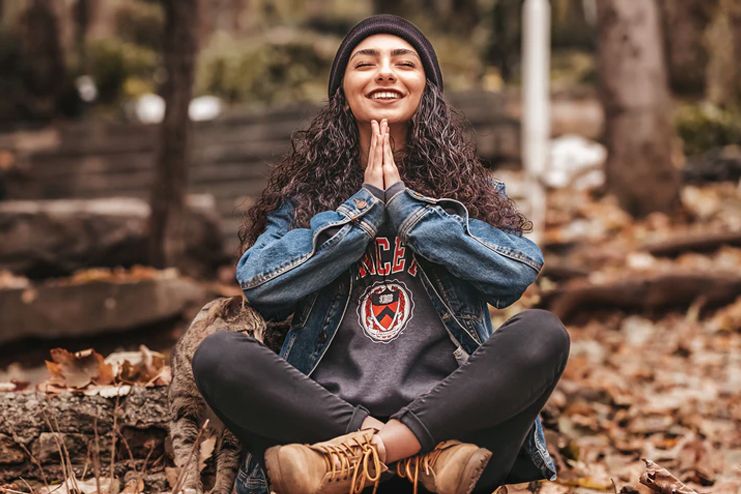 This pose is basically to achieve the meditation stage. Meditation is not easy. It is supposed to be a blank space in your mind and complete silence should be followed and this you must maintain for as long as you can. This is a whole experience. You can do this whenever you feel stressed during the day.
This pose is basically to achieve the meditation stage. Meditation is not easy. It is supposed to be a blank space in your mind and complete silence should be followed and this you must maintain for as long as you can. This is a whole experience. You can do this whenever you feel stressed during the day.
Step-by-step guide
-Sit straight and close your eyes
-Hands on your lap with index finger touching the thumb
-Chant Om
-Keep your head blank
-Deep inhale and exhale through your nostrils
-Try to fight the distractions till you achieve complete blackness and silence
How Can we learn this Tantric Yoga and Exactly where?
 There are many places where you can join a tantric yoga community. Tantric yoga teachers often can teach power yoga, and regular yoga too. They are experienced in physiology and therapy both. They know about each body part an organ function, to give you the best poses with you can benefit the most from. It is important to consult at least once online or offline any tantric yoga trainers you may know.
There are many places where you can join a tantric yoga community. Tantric yoga teachers often can teach power yoga, and regular yoga too. They are experienced in physiology and therapy both. They know about each body part an organ function, to give you the best poses with you can benefit the most from. It is important to consult at least once online or offline any tantric yoga trainers you may know.
1. Join a class
Practicing tantric yoga is a journey of a lifetime. When somebody takes up this profession, they decide to go all the way towards attaining touch with their own spirituality and also help others. Nowm because of Facebook and Instagram many people conduct classes online.
2. At home
You may not want to practice tantric yoga in a group. Youtube has many tantric yoga trainers who offer their yoga sessions for free to the viewers. Make sure you follow proper form and instructions they are telling about in these videos.
Can we do this alone? Or do we need a partner for this?
 You don’t need a partner for tantric yoga, but if you want you can practice with a partner too. It improves your sexuality and heals any bad experiences or memories you may have.
You don’t need a partner for tantric yoga, but if you want you can practice with a partner too. It improves your sexuality and heals any bad experiences or memories you may have.
Advantages of Practicing Tantric Yoga?
1. Relieves from stress, anxiety and depression
2. Improves digestion and respiration
3. Makes you confident
4. Improves focus and concentration
5. Starts a process of inner healing
FAQ’s:
Should I meet Tantric experts before starting this Tantric Yoga
Since tantric yoga is a lot about breathing patterns and proper form. It is advisable to consult experts before you start completely by yourself.
How often can I do this in a week?
You can practice tantric yoga maximum up to twice a day. You can also practice asanas and mudras based on your needs spread across the day. Regular tantric yoga-same time every day- is bound to give better results.
Can I do this yoga on my periods?
Not all poses of tantric yoga can be performed during menstruation. Consult a specialist before trying out tantric yoga during your periods.
Does this help me increase in testosterone?
Hormonal activity is bound to improve with regular practice of tantric yoga. But there is no scientific research which points to an increase in levels of testosterone because of tantric yoga.



















